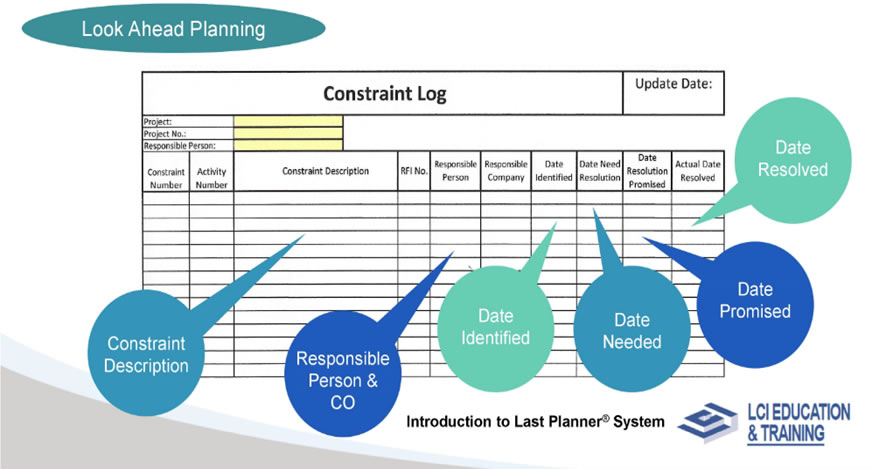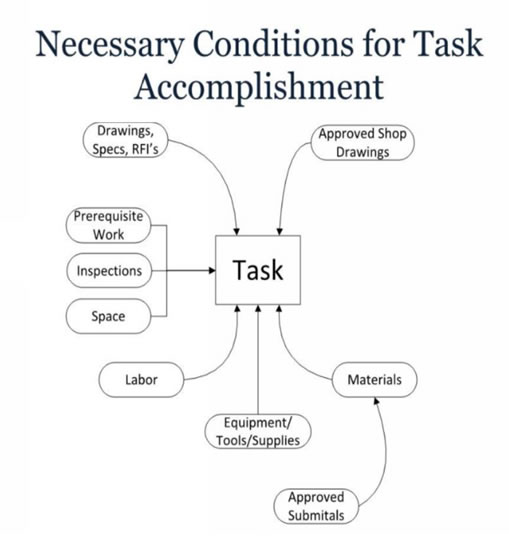Constraint Management
Constraint log management could be the single most valuable tool from LCI’s Last Planner System™ process. However, project teams are often inconsistent and misuse the tool, and so they don’t always realize the value of constraint management.
What are teams doing wrong, that prevents constraint management from being successful? Here are a few reasons…
1. They use the commitments on the constraint log as ammunition for the big bad blame guns, so they can aim it on the group or person who failed to deliver on the constraint log.
In my experience as a superintendent, I would focus the blame on the person or the group who failed to deliver, and it was because I did not understand the alternative. When I hit a roadblock, I blamed the design team, the owner, or the BIM guys. Once, I even blamed the food truck guy for a three-day delay in formwork. (Most of the formwork crew called in sick for two days with…let’s call it intestinal distress. I needed my two days back!)
As my understanding of constraints grew, I learned that blaming the person did not EVER solve the root cause of the problem. There is always a reason why a person could not deliver on their commitments. The alternative to blaming the person is to blame the problem. To all you superintendents reading this and thinking to yourself “but the person is the problem!” you are wrong.
I encourage you and your teams to take the time to flush out why the constraint was not resolved by the commitment date. The trail will often lead back to something you can take action on as a superintendent. Your people will feel like you’re helping them when you address the root cause of their failure to remove the constraint. A good way to do this is through the 5 Why process.
2. Constraint analysis is not performed by the right people at the right time.
This is due to lack of understanding regarding how the constraint analysis should be executed. Constraint analysis should be done through all phases of construction, recorded, and reviewed in all meetings. The scheduled look-ahead meetings should produce the constraints.
The LCI standard is to identify constraints six weeks out, but I can tell you that it is very difficult for trade foremen to focus field activities that far in advance. Field teams should look at least two to three weeks ahead. After all, these are the guys responsible for work now. They should focus their effort on these types of constraints:
- equipment,
- materials,
- manpower,
- pre-requisite work,
- supplies,
- inspections, and
- space to complete the work.
Teams will need superintendents, project managers, and project managers of trades to analyze activities three to eight weeks out. This group should focus on these types of constraints that take a little longer to plan out:
- approved submittals,
- shop drawings,
- fabrication,
- RFIs,
- change order approvals, and
- other procurement related items.
If these items are continually being brought up by your field foreman, there is a disconnect between field and office operations.
3. Teams are often inconsistent with identifying constraints, adding them to the log, and reviewing the constraints log during meetings.
The OAC meetings and internal team meetings should provide a resolution to the constraints. Do not preach to your trades to list constraints only to let them go unaddressed by you or the project managers, design team, or owner. Your trades will lose faith in the process and ultimately devalue the time put in to identifying the constraints. The constraint log should have one person responsible for distributing, updating, and reviewing in all project meetings. Whomever is listed as the person resolving the constraint should agree to the commitment date and provide progress updates on the resolution at each relevant meeting.
The items on the constraint log will impact flow of work to the project, and this must be communicated to and understood by all involved. This is why a regular review of the constraint log or constraint board is so important. At each huddle or OAC meeting, walk through the constraint log and identify constraints that are coming due within the next few weeks and ask the responsible person to speak to it. Make this an agenda item so it is not ignored. think about how you have conversations around these items. Instead of asking, “What is the hold up here, Mr. Architect?”, try asking them if they need more information to answer the RFI. This will provide the reminder that the team needs an answer without blaming or shaming the person you’re talking to.
What is a constraint log board?
If your team makes the commitment to consistently analyze scheduled tasks far enough in advance for those responsible to resolve the constraint, then your team will reduce or eliminate workflow interruptions. As people adjust to the consistency of the constraint log, accountability levels will rise.
The Lean Builder on LinkedIn
Be sure to follow The Lean Builder on LinkedIn!











